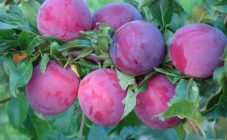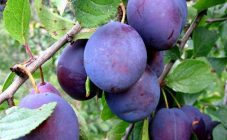Content:
The climatic conditions of most of the territory of Russia require the cultivation of crops that are characterized by adaptability and resistance to adverse environmental factors. One of these is the Ussuriyskaya plum.
Short description
Ussuriyskaya (Far East) plum is considered the most northern type of plum. It usually grows in the southern regions of the Far East and Manchuria.
The main advantage of this variety is its high winter hardiness, which provides a very wide area for growing crops. During flowering, which is usually lush and abundant, even frosts down to -20 ° C are not capable of harming the flowers.
The bark of the plant is brown or grayish. Shoots are fragile or brittle, often injured under the pressure of the crop. The fruit is smaller than other plum varieties.
The best varieties of the Ussuriyskaya plum
There are several varieties of the Far Eastern plum. The most important ones are the following:
- Ural prunes... The tree reaches 2 m in height. It is characterized by an expanded and spreading crown. The annual harvest with well-built agricultural technology reaches 15 kg. Fruits are oval, usually weighing 13-15 g. The peel is medium-thick, deep purple in color. The pulp is not very dense, colored in light colors. The plum is sweet to taste, with a slight astringency.
- Snow White... The tree grows up to 2.5 m. The crown diameter is about 4 m. It is characterized by increased productivity, which allows you to collect up to 30 kg of high-quality harvest from each tree. Fruits are regular rounded with a whitish bloom and light yellow skin. By weight, they reach 30 g, there is a well-noticeable sourness in the taste.
- Yellow Hopty... Plants 2.5 m high with a powerful spreading crown. Fruits are bright yellow, weighing 17-20 g. The pulp is juicy and tasty, the stone is poorly separated from it.
- Ural yellow... The height of an adult tree is about 2.5 m. An early variety, the fruiting of which begins in the first decade of August. Average yield: up to 10-15 kg can be harvested from one plant. Fruits with a yellowish peel and pulp, weighing up to 16 g. The varietal characteristic of plums is their sweet taste, which is rated by tasters at 4.5 points out of 5.
- Golden cornfield... Adult plants grow up to 2 m. The crown is broadly spreading, powerful. Fruiting begins in the second or third half of August. During the season, it is possible to collect up to 15 kg of high-quality fruits from one tree, the average weight of which is 15 g. The fruits are juicy, with good taste. Both the pulp and the rind are deep yellow. The pulp is easily separated from the stone. The variety has a long shelf life.
- Dawn of Altai (Ussuriyskaya 25-15). Trees 2 m high. The crown is slightly thickened. This is the most winter-hardy variety among all subspecies. Forms remarkable bright red oblong fruits.
- Pioneer... Plants grow up to 2.5 m in height. Fruit weight is about 17-20 g. They have a rich red skin. Juicy and very tasty pulp, also colored red, is a characteristic feature of the variety.
Description of fruits
Depending on the variety, fruits vary in weight within 20-25 g. The shape is most often rounded, although pointed or oblong specimens are found. The stone is usually small and, as a rule, does not separate well from the pulp.The taste of the fruit is predominantly sweet, sometimes with the addition of sourness. A slight bitterness is often felt closer to the bone. Fruit color is as follows:
- dark burgundy;
- whitish;
- purple;
- yellow;
- black with a red bloom.
Plum planting
The Ussuri plum is usually planted in elevated areas with good access to sunlight. Most often these are slopes located on the south or southwest side. The site should be protected from cold winds if possible.
Ussuriyskaya plum is bad for high snow cover, which provoke damping of roots. For the same reason, plant seedlings should not be planted near fences, as well as on piedmont plots.
A distinctive feature of the plant is poor growth on oxidized soil. Annual growths become much shorter, much less nutrients are supplied to plants, and productivity drops.
Landing
Saplings are planted according to the standard scheme for plums. A hole is dug at the site, approximately 1 m deep and approximately 80 × 80 cm in size. Near the center of the deepening, a wooden oblong peg with a height of about 1-1.5 m is placed and tightly hammered into the ground with its sharp end down. After that, a seedling is placed in the hole and its roots are straightened so that they do not overlap with each other and bend over the edges of the hole.
The seedling is covered with soil from the pit so that the soil layer is 5-7 cm below the location of the root collar of the tree. After that, a shallow groove is dug around the plant, into which 2-3 buckets of water are immediately poured. Without wasting time, the soil must be mulched so that moisture is preserved in the plant. To improve growth, it is recommended to add top dressing to the soil when filling the seedling. It is recommended to use it as:
- compost;
- wood ash;
- rotted manure;
- superphosphate.
Pollination
Most varieties of the Ussuriyskaya plum are self-fertile. This property does not allow plants to pollinate with their own pollen, or it sharply limits this possibility. To obtain a normal, high-quality crop, it is recommended to plant pollinators. Most types and varieties of plums can be used for pollination, with the exception of Chinese. This variety usually enters the flowering phase a week after the Far Eastern plum.
Further care
In the first year of growing a seedling, usually no pruning is carried out. Starting from the second year, it is necessary to carry out the formation of the crown. Sanitary pruning of the tree is especially important, which is carried out to remove dried, severely injured shoots, as well as branches with signs of serious illness.
The groove that was dug around the seedling during planting for irrigation is recommended to be saved for the future. Subsequently, each watering must be carried out directly into this deepening. After each irrigation, it is recommended to loosen the soil in order to facilitate the access of moisture and oxygen to the roots and at the same time get rid of weeds. Subsequent mulching is also mandatory, for which, in addition to the soil mixture, it is allowed to use peat or straw manure.
According to the description of the Ussuri plum, it does not tolerate the lack of moisture, as a result of which watering should be regular and carried out at least once every 1.5-2 weeks. About 10 liters of water are poured onto each plant.
The species does not differ in resistance to pests and ailments. Usually Ussuriyskaya plum is affected by such diseases as:
- gray rot;
- sooty fungus;
- rust;
- clasterosporium disease;
- coccomycosis;
- root cancer;
- fruit rot.
The tree can be damaged by the following pests:
- sawflies;
- leaflet;
- moths;
- aphid.
It is customary to use appropriate fungicides and insecticides to protect the plant. The dosage and method of use are usually indicated on the package.
Fruiting in a plant most often begins in 3-4 years of cultivation, and in the growing season falls on the end of August - beginning of September. When fully ripe, the fruits usually crumble quickly, so it is recommended to harvest them slightly unripe.
The cultivation of the Ussuri plum is not difficult. With proper care, the yield will be of high quality and high.















